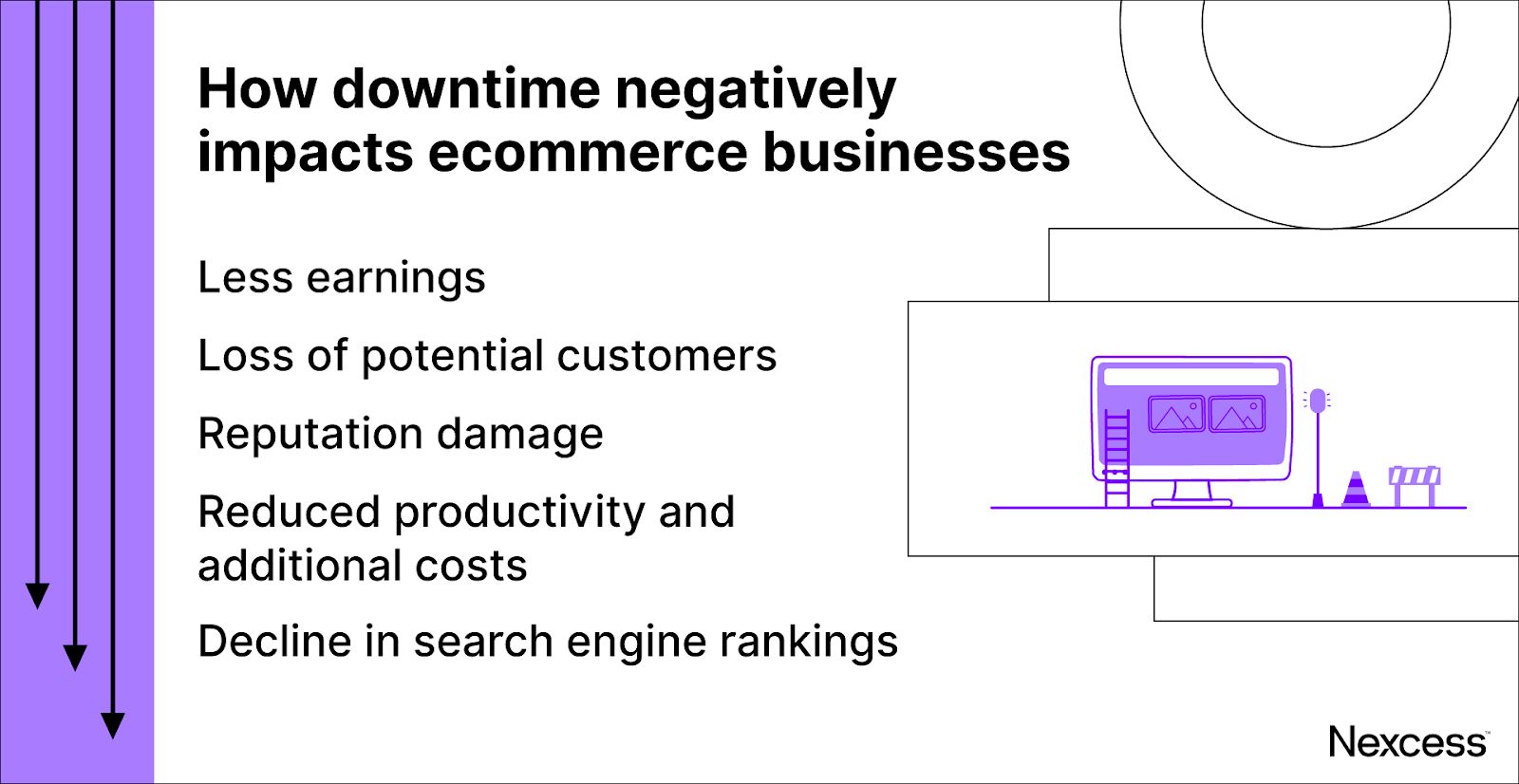Ecommerce downtime is a major concern for ecommerce businesses. After all, online store downtime is similar to closing down a physical store.
And just as shoppers visit other stores when one is closed, online users will quickly move to a different ecommerce website if yours is down. The result? You lose out on business and risk damaging your reputation and online presence long-term.
It doesn’t help that ecommerce downtime occurs more frequently than you might think. Uptime Institute's 2022 Data Center Resiliency Survey backs that up, showing that 80 percent of data center managers and operators experienced some downtime between 2020 and 2022.
Even more concerning, one in five companies experienced severe outages that resulted in significant damage. How "significant" are we talking about? Well, over 60 percent of downtimes resulted in at least $100,000 in total losses between 2020 to 2022.
The higher the earnings, the higher the cost of downtime. But if you aren’t sure about the cost it carries for your business, keep reading. We’ll explore how to calculate the true cost of ecommerce downtime and the best ways to reduce its impact on your business.
But first, let’s dive into what causes it.
- What causes ecommerce downtime?
- Downtime calculation formula
- How downtime negatively impacts ecommerce businesses
- How to minimize the impact of downtime on ecommerce businesses
- Final thoughts: How to reduce the impact of downtime in ecommerce
What causes ecommerce downtime?

Some of the common reasons behind ecommerce downtime include:
Human error
Ecommerce downtime or outages can be caused by human error. For example:
- Technical mistakes during upgrades or maintenance tasks. An employee might accidentally delete critical files, misconfigure server settings, or introduce bugs into the codebase.
- Security breaches due to weak passwords, misconfigured security settings, and failure to install security updates. Hackers can exploit these vulnerabilities to steal customer data, inject malware into the website, or hijack user sessions. Human error is responsible for 88 percent of data breaches.
- Scheduling errors that result in a lack of resources to handle technical issues in the ecommerce platform.
Sell your products online, worry-free
Officially recommended by WooCommerce, our hosting is made for online businesses like yours
Software flaws
Errors and downtime are more likely to occur when your online store is integrated with external software and apps. Sometimes integrations don't go as planned, and your ecommerce store may have compatibility issues with external software.
Integrating external software can also pose security risks. If an app or software has vulnerabilities, it could compromise the security of your ecommerce site, leading to business downtime.
Cyber attacks
Cyber attacks by hackers and sometimes disgruntled employees are another major reason for ecommerce downtime. Hackers can exploit vulnerabilities in online business systems and gain access to sensitive information or cause damage to infrastructure.
A study of 200 UK ecommerce leaders found that 82 percent of businesses witnessed increased security threats between 2020 and 2022.
Another study on the potential effects of cyber attacks found that sensitive data exposure was the biggest worry for 65 percent of people in 2022. Downtime was the second biggest concern, with 57.6 percent of respondents worried about it.
Planned downtime
Scheduled maintenance and updates are considered planned downtime because they are intentional and typically scheduled during off-peak hours to minimize their impact on customers.
Planned downtime is crucial to maintain your online store's stability, security, and up-to-date features. However, even during planned downtime, the ecommerce platform may become temporarily unavailable or experience reduced functionality, leading to lost revenue.
In essence, downtime carries a cost regardless of the cause. But how do you calculate it?
Downtime calculation formula
You can calculate the downtime cost by multiplying the number of minutes the downtime lasted by the cost per minute.
Downtime cost = downtime minutes X cost per minute.

Let's say an online retailer earns an average of $25,000 per day. That means they can earn $1041.67 per hour or $17.36 per minute.
Now, suppose there's a downtime of 30 minutes.
Then, the downtime cost = 30 (downtime minutes) X $17.36 (cost per minute). That means the retailer's downtime cost for 30 minutes is $520.83.
If you need help calculating the downtime cost for your business, you can use the downtime calculator created by Rewind.
How downtime negatively impacts ecommerce businesses

Some of the ways in which downtime affects ecommerce businesses are more obvious than others. But ultimately, they all have an effect on your bottom line.
Here’s a quick rundown.
Less earnings
The same 200 UK ecommerce leaders survey mentioned previously showed that enterprises with more than £10 million in revenues lost over 10 percent of their revenues to downtime between 2020 to 2022.
But they aren’t the only ones. Take these two very costly ecommerce downtime in recent times:
- Amazon lost $34 million on June 8th, 2021, when the internet stopped working for just over an hour.
- Facebook, Messenger, Instagram, and WhatsApp lost $79 million in advertisement revenues because of a seven-hour outage on October 4th, 2021.
Loss of potential customers
Online shoppers can switch stores in seconds, so you lose business for every second your ecommerce store faces downtime. Websites that load in one second have a 5X higher conversion rate than those that take five seconds.
Reputation damage
Slow or frequently down websites dampen your company's reputation as well. According to PwC’s 2022 Customer Loyalty Survey, over 50 percent of participants claimed that they'd likely switch brand loyalties if their online shopping experience with a brand wasn't as easy or enjoyable as it was when shopping in physical stores.
With social media being so popular, unhappy buyers can easily share their poor customer experience stories with others online, harming your ecommerce business's reputation.
Reduced productivity and additional costs
Your team can’t work if your website is down. Moreover, getting your ecommerce site back up can take a few days, meaning you'll likely have to pay employees extra for the time they spend fixing it.
Decline in search engine rankings
Ecommerce downtime can negatively impact your SEO ranking on search engines because they give higher rankings to active websites. While you can recover from it, it’s a setback that carries a cost to fix.
How to minimize the impact of downtime on ecommerce businesses

While downtime is sometimes necessary and you can't always prevent the external causes, you can minimize the impact of downtime on your business. Here are some proven ways:
Perform regular website testing
To prevent your website from going down, you can test it for potential problems. Some ways to consistently test your website include:
- Load testing. It helps simulate high traffic levels on your website to see how it performs under heavy loads.
- Uptime monitoring. It helps check your website's availability at regular intervals. If there's an issue, you'll receive an alert so that you can take action.
- Vulnerability scanners. They help scan your computer systems and networks for security weaknesses, helping identify vulnerabilities attackers could exploit, such as outdated software or misconfigured settings.
Schedule timely software updates and data backups
To keep your website running smoothly, keep your software and plugins up to date and install security patches. Doing so helps prevent cyber attacks and software glitches that cause downtime. Consider using a security plugin to help detect and address potential vulnerabilities.
Moreover, regularly save copies of your website's data and have a plan in case something goes wrong. It will help you get your website up and running faster if it ever faces downtime.
Have a clear communication policy in place
Having a transparent customer communication plan could work wonders for your brand image. That might include notifying customers before or after downtime occurs, providing regular updates, and compensating them if needed.
You can also take internal preventive measures to reduce downtime resulting from human error.
Opt for a reliable hosting provider
When looking for reliable and secure web hosting, look for companies that guarantee high uptime and have an excellent track record performance-wise. Choosing a dependable hosting provider like Nexcess would hugely help in minimizing downtime.
Final thoughts: How to reduce the impact of downtime in ecommerce
Downtime is a reality for ecommerce businesses, but how you manage it might make all the difference in your success as an online business owner.
The costs of ecommerce downtime aren't restricted to losing out on business. Your reputation, ranking, and client relationships are at stake here. You can significantly minimize downtime issues by taking the steps mentioned above.
Choosing a reliable hosting provider can be crucial to reducing downtime risks. Nexcess enterprise hosting can guarantee impressive performance for your ecommerce store. Try it out today.

